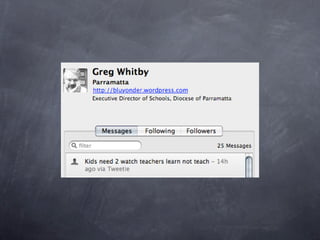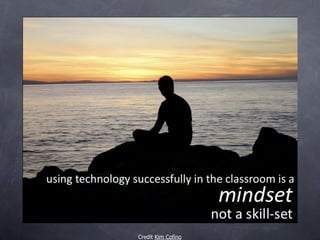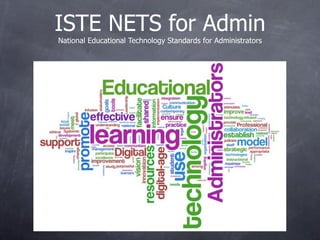Web 2.0 for Learning
- 1. John Maschak Apple Canada Gerry Paille BC SD 60 Peace River North
- 4. ISTE NETS for Students National Educational Technology Standards for Students
- 5. ISTE NETS for Teachers National Educational Technology Standards for Students
- 8. What students really need are small, lightweight tools to help them learn. Andre Malan: http://tinyurl.com/nxv8dm
- 12. But... “And don't swallow the myth of the digital native. Just because your teens Facebook, IM, and Youtube, don't assume they know the rhetoric of blogging, collective knowledge gathering techniques of taggers and social bookmarkers, collaborative norms of wiki work, how to tune and feed a Twitter network, the art of multimedia argumentation - and, by far most importantly, online crap detection.” Howard Rheingold
- 13. Bloom’s Taxonomy From Nouns to Verbs
- 14. Web 2.0 Verbs Ripping, remixing, commenting, blogging, social bookmarking, sharing, podcasting, vlogging, modelling, linking, chatting, texting, broadcasting, visualizing, animating, publishing, collaborating, communicating, uploading, downloading, tagging...
- 17. What Do You Think About This Distinction? 1. Teachers who teach curriculum want: 1. Attendance and participation monitoring 2. Quizzes and Gradebooks 3. Content management and distribution of teacher created and filtered resources 2. Teachers who teach learning want: 1. Tools for individual and collaborative construction 2. Tools for reflection, self and group assessment 3. Content management (tags, spaces, organizational views) of teacher, student created and web resources 4. Spaces for exploration and discovery 5. Networks for developing learning skills and social skills 6. Aggregators for assessing net-wide student artifact construction 3. Teachers who want it all! Dr. Terry Anderson’s Presentation MoodleMoot Canada 2009 Follow the Interesting Discussion from the Chronicle Of Higher Learning
- 20. “My goal is to give my readers the front line experiences with web 2.0 tools in my classroom, not just a glossy review.” Jared Nichol
- 21. Text Text This wiki was started by Kevin Amboe as his first Wiki. This space has been created to become a resource for those interested in learning and sharing about teaching and learning in the 21st Century.
- 24. 20 hours per minute uploaded 14,000 plus Hollywood Movies per day.
- 28. ISTE NETS for Admin National Educational Technology Standards for Administrators
- 31. Attributions College Humor (2009, June 29) Web Site Story. Retrieved July 1, 2009, from College Humor Web site: http:// www.collegehumor.com/video:1913584 ISTE (2007, June) National Educational Standards for Students. Retrieved March 24, 2009, from ISTE Web site: http://www.iste.org/Content/NavigationMenu/NETS/ForStudents/2007Standards/ NETS_for_Students_2007.htm ISTE (2008, June) National Educational Standards for Teachers. Retrieved March 24, 2009,from ISTE Web site: http://www.iste.org/Content/NavigationMenu/NETS/ForTeachers/2008Standards/ NETS_for_Teachers_2008.htm Whitby, Greg (2009, May 26). Kids need 2 watch teachers learn not teach. Retrieved March 24, 2009 from Twitter Web site: http://twitter.com/gregwhitby Churches, Andrew (2008, March 14). 21st Century Teacher. Retrieved March 24, 2009 from Educational Origami Web site: http://edorigami.wikispaces.com/21st+Century+Teacher Andremalan.net (2009, June 26). Personal Learning Environments. Retrieved June 26, 2009, from andremalan.net Web site: http://andremalan.net/2009/06/personal-learning-environments/ Drexler, Wendy (2008, November 26) The Networked Student. Retrieved March 24, 2009, from YouTube Web site: http://www.youtube.com/watch?v=XwM4ieFOotA Rheingold, Howard (2009, April 10) 21st Century Literacies. Retrieved April 10, 2009, from The San Francisco Chronicle Web site: http://www.sfgate.com/cgi-bin/blogs/rheingold/detail?blogid=108&entry_id=38313 Churches, Andrew (2009, March 6). Bloom’s Digital Taxonomy. Retrieved March 24, 2009, from Wikispaces Web site: http://edorigami.wikispaces.com/Bloom%27s+Digital+Taxonomy. Anderson, Terry (2009, April 3). Beyond Learning Management to Open Learning Support and Inspiration. Retrieved April 3, 2009, from Slideshare Web site: http://www.slideshare.net/terrya/beyond-lms-keynote-to- canada-moodlemoot-2009 Cofino, Kim (2009, March 9) A Mindset, Not a Skillset. Retrieved April 21, 2009 from Flickr Web site: http:// www.flickr.com/photos/superkimbo/3318863498/ ISTE (2009, June) National Educational Standards for Administrators. Retrieved July2, 2009,from ISTE Web site: http://www.iste.org/Content/NavigationMenu/NETS/ForAdministrators/2009Standards/ NETS_for_Administrators_2009.htm
- 32. http://tinyurl.com/lvsf9p maschak at apple dot com gpaille at prn dot bc dot ca































